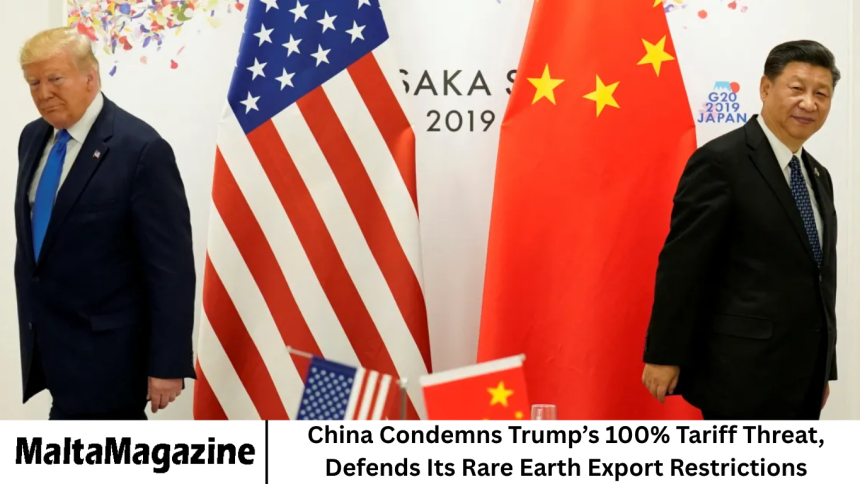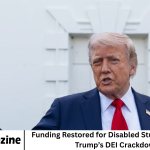In a major escalation of trade tensions, China has sharply criticized former U.S. President Donald Trump’s recent threat to impose a 100% tariff on all Chinese imports, calling it “reckless protectionism” and warning that such measures could destabilize the global economy.
- Trump’s Tariff Threat Rekindles Trade Tensions
- China’s Sharp Response: “Protectionism at Its Worst”
- Rare Earth Export Curbs: Beijing Defends Its Policy
- Why Rare Earths Matter So Much
- Global Reactions to the Renewed Trade Threats
- The Historical Context: From Trade War to Tech Rivalry
- Economic Impact: What Analysts Are Saying
- China’s Strategic Use of Rare Earths
- Environmental and Economic Justifications
- Possible U.S. Countermeasures
- The Broader Implications for Global Trade
- China’s Message to the World: Cooperation, Not Confrontation
- Frequently Asked Question
- Conclusion
At the same time, Beijing has defended its recent curbs on rare earth exports, arguing that they are consistent with international law and necessary to protect national security and sustainable development.
The exchange marks a new chapter in the increasingly tense U.S.-China trade relationship, which continues to influence global markets, technology supply chains, and diplomatic relations across multiple regions.
More Read: Dezerv Raises ₹350 Crore to Boost Wealth-Tech Expansion
Trump’s Tariff Threat Rekindles Trade Tensions
Donald Trump, who is again seeking the Republican nomination for the 2024 U.S. presidential election, recently announced that if re-elected, he would impose a 100% tariff on all goods imported from China.
The statement, delivered during a campaign rally, was intended to signal a tough stance on trade and economic dependence on China. Trump claimed that the measure would “bring manufacturing back to America” and “end China’s exploitation of U.S. markets.”
The proposed tariffs would far exceed those introduced during Trump’s first term, when his administration levied tariffs ranging from 10% to 25% on over $360 billion worth of Chinese imports, sparking a trade war that disrupted global supply chains and slowed economic growth in both countries.
If enacted, a 100% tariff could have far-reaching implications for global trade and consumer prices. U.S. businesses that rely heavily on Chinese manufacturing—especially in electronics, machinery, and consumer goods—would likely face significant cost increases.
Analysts warn that such a policy could reignite inflationary pressures and provoke a retaliatory response from Beijing.
China’s Sharp Response: “Protectionism at Its Worst”
Beijing’s reaction to Trump’s remarks was swift and stern. The Chinese Ministry of Commerce issued a statement calling the proposed tariffs a violation of World Trade Organization (WTO) principles and an example of “protectionism at its worst.”
A ministry spokesperson stated,
“China strongly opposes any form of trade bullying. The threat of imposing 100% tariffs is not only economically irrational but also politically motivated. Such actions would harm both China and the United States and disrupt the global supply chain.”
Chinese officials emphasized that trade between the two countries remains mutually beneficial, noting that U.S. consumers and companies would bear the brunt of higher costs.
They urged Washington to engage in dialogue rather than confrontation and warned that Beijing “will take all necessary measures” to defend its interests if such policies are implemented.
Rare Earth Export Curbs: Beijing Defends Its Policy
Alongside its criticism of Trump’s tariff rhetoric, China also defended its recent decision to tighten export controls on rare earth materials, which are essential components in high-tech products such as smartphones, electric vehicles, wind turbines, and defense systems.
China currently produces around 70% of the world’s rare earth elements, giving it substantial influence over the global supply chain. In July, Beijing announced that companies exporting certain rare earth compounds and technologies must obtain special government approval.
Citing “national security and environmental protection” concerns. Western governments and companies have expressed alarm at the move, fearing potential disruptions in the supply of key materials needed for green technologies and military equipment.
The United States, Japan, and the European Union have all called for greater diversification of rare earth sources.However, Chinese officials argue that the restrictions are lawful and necessary. A spokesperson for China’s Ministry of Industry and Information Technology said,
“The management of rare earth exports is consistent with international trade rules. It ensures that our resources are developed in a sustainable way and prevents their misuse for purposes that may threaten China’s national security.”
The statement emphasized that China would “continue to support legitimate global trade” while protecting its strategic resources.
Why Rare Earths Matter So Much
Rare earth elements (REEs) are a group of 17 metallic elements that play a critical role in modern technologies. They are key to manufacturing semiconductors, magnets, batteries, and military-grade sensors. Without them, industries such as renewable energy, defense, and consumer electronics would face serious challenges.
Despite their name, rare earths are not particularly rare in nature—but their extraction and processing are complex, costly, and environmentally hazardous. China has built a dominant position in the sector by investing heavily in refining technologies and tolerating the environmental costs that other nations have avoided.
This dominance has made the world’s tech and defense industries highly dependent on Chinese exports. When Beijing hinted at restricting rare earth supplies during previous trade disputes, it caused sharp price spikes and panic among manufacturers worldwide.
Now, with Trump’s proposed tariffs threatening to further strain U.S.-China relations, concerns are mounting that rare earths could once again become a geopolitical bargaining chip.
Global Reactions to the Renewed Trade Threats
Reactions to Trump’s 100% tariff proposal and China’s rare earth stance have been mixed across the global political and economic landscape.
In the United States: Divided Opinions
American manufacturers and business groups have largely opposed the idea of 100% tariffs. The U.S. Chamber of Commerce warned that such measures would “inflict enormous harm on American consumers and exporters,” arguing that trade barriers would push up prices and invite retaliation.
However, some political supporters of Trump praised the idea, viewing it as a bold step to protect American industries and reduce dependence on China. Several Republican lawmakers endorsed the proposal as part of a broader effort to counter China’s influence in global trade.
In Europe and Asia: Caution and Concern
European Union officials expressed unease over the escalation, noting that renewed trade tensions between the U.S. and China could undermine the fragile global economic recovery. Asian economies closely tied to China’s supply chains, such as South Korea, Taiwan, and Malaysia.
Also voiced concern that disruptions could affect semiconductor and electronics production. Japan, a major importer of Chinese rare earths, said it would “closely monitor” developments and accelerate efforts to diversify supply sources.
Australia, one of the few countries with significant rare earth reserves, reiterated its commitment to expanding mining operations to reduce global dependence on China.
The Historical Context: From Trade War to Tech Rivalry
The current tension echoes the U.S.-China trade war of 2018–2019, when the Trump administration imposed tariffs on hundreds of billions of dollars’ worth of Chinese goods. Beijing retaliated with its own tariffs and hinted at restricting rare earth exports, sending shockwaves through financial markets.
While the “Phase One” trade deal signed in early 2020 temporarily eased tensions, structural issues—such as intellectual property rights, technology transfers, and industrial subsidies—remained unresolved.
The outbreak of the COVID-19 pandemic, followed by rising geopolitical rivalries over technology and Taiwan, has since deepened distrust between the two powers. Today, the competition has evolved beyond trade into a strategic rivalry encompassing technology, military power, and global influence.
The U.S. has introduced restrictions on Chinese access to advanced semiconductors and AI technologies, while China has strengthened its domestic innovation drive under the “Made in China 2025” and “Dual Circulation” strategies.
Economic Impact: What Analysts Are Saying
Economists warn that Trump’s 100% tariff proposal could have severe consequences for both economies if implemented. According to analysts at the Peterson Institute for International Economics (PIIE), a 100% tariff would effectively double the price of many consumer goods in the United States.
Such as electronics, furniture, and clothing. The average American household could face an additional $1,000–$2,000 per year in costs. For China, the impact would depend on how much it can redirect exports to other markets.
Beijing has been expanding trade ties with Southeast Asia, Africa, and Latin America to reduce dependence on the U.S. market. Nevertheless, losing access to the world’s largest consumer economy would still be a major blow.
Global markets could also suffer. Investors typically react to trade uncertainty by shifting toward safe-haven assets such as gold and the U.S. dollar. Supply chain disruptions might push up the prices of raw materials and intermediate goods, further fueling global inflation.
China’s Strategic Use of Rare Earths
China’s control over rare earths gives it a powerful strategic lever in trade negotiations. Experts suggest that if the U.S. were to impose 100% tariffs, Beijing might respond by further restricting rare earth exports to the U.S., potentially crippling sectors such as defense and clean energy.
In 2010, China temporarily reduced rare earth exports to Japan during a diplomatic dispute, demonstrating the leverage it holds. Since then, other countries have tried to develop alternative sources, but China’s technological and infrastructural lead remains significant.
Beijing’s latest export curbs are widely seen as a warning signal—not a complete embargo but a reminder that it can influence critical supply chains if provoked.
Environmental and Economic Justifications
China also frames its rare earth policies within the context of environmental sustainability. The mining and processing of these elements involve toxic waste and radioactive byproducts, leading to significant ecological damage in past decades.
By tightening export controls, Beijing claims it is ensuring that domestic producers follow stricter environmental standards and that rare earths are used more responsibly. Critics in the West, however, view this justification as a convenient cover for geopolitical strategy.
Still, the move aligns with China’s broader push toward “green development” and a transition to high-tech industries. By maintaining greater control over rare earth exports, Beijing can also drive up global prices, benefiting its domestic producers.
Possible U.S. Countermeasures
The U.S. government has long recognized the risks of over-reliance on Chinese rare earths. In recent years, Washington has taken steps to build domestic processing capacity and forge alliances with other resource-rich countries.
Projects in Texas, California, and Nevada aim to revive rare earth mining, while the Pentagon has funded initiatives to secure supply chains for defense applications. Partnerships with countries like Australia and Canada are also part of this strategy.
However, experts warn that rebuilding a full rare earth supply chain—from mining to refining and manufacturing—could take years or even decades, given the technical and environmental challenges.
If Trump’s 100% tariff policy were enacted, the U.S. might accelerate these efforts dramatically. But in the short term, consumers and industries would face disruptions and higher costs.
The Broader Implications for Global Trade
The renewed confrontation between China and the U.S. could reshape global trade patterns. As both countries adopt more protectionist policies, other economies might realign their trade strategies.
Southeast Asian countries like Vietnam, Indonesia, and Thailand could benefit as alternative manufacturing hubs, while India has been positioning itself as a “China-plus-one” destination for global companies seeking to diversify.
At the same time, multilateral institutions such as the WTO may struggle to mediate between two superpowers that increasingly favor unilateral action over international consensus.
China’s Message to the World: Cooperation, Not Confrontation
Despite its firm stance, Beijing insists it remains open to dialogue. Chinese state media have emphasized that cooperation between the U.S. and China remains essential for global stability, particularly in areas such as climate change, public health, and technology innovation.
An editorial in the People’s Daily stated,
“China will not be intimidated by tariff threats. But we believe cooperation is better than confrontation. The two largest economies in the world should work together to promote fair and sustainable trade.”
Whether Washington and Beijing can return to meaningful negotiations remains uncertain. With the U.S. presidential campaign in full swing, trade with China has once again become a major political issue—one that could define the next phase of global economic policy.
Frequently Asked Question
What exactly did Donald Trump propose regarding tariffs on China?
Donald Trump proposed imposing a 100% tariff on all Chinese imports if he returns to the presidency. This means every product imported from China would face double the current cost at U.S. borders. The proposal is intended to pressure Beijing over trade practices but could trigger severe economic repercussions.
Why did China condemn the 100% tariff threat?
China criticized the plan as protectionist and politically motivated, saying it violates WTO principles and harms global trade. Beijing argues that such tariffs would damage both economies and cause unnecessary instability in global supply chains.
What are rare earth elements, and why are they important?
Rare earth elements (REEs) are 17 metallic elements used in critical technologies like smartphones, electric vehicles, renewable energy systems, and defense equipment. China dominates global production and refining, making it a central player in these industries.
Why did China restrict rare earth exports?
China said the export curbs are meant to protect national security, environmental sustainability, and resource management. It claims the measures are consistent with international trade laws. Critics, however, believe the move is also a geopolitical strategy to counter U.S. pressure.
How could Trump’s tariffs affect the U.S. economy?
A 100% tariff would likely cause a surge in consumer prices and increase costs for U.S. manufacturers that depend on Chinese parts and materials. Economists estimate it could add thousands of dollars per year to household expenses and slow economic growth.
Could China retaliate against the U.S.?
Yes. China could respond by restricting rare earth exports, imposing its own tariffs, or targeting U.S. companies operating in China. Given its dominance in key materials and supply chains, Beijing has several tools to counter U.S. actions.
What is the global impact of these renewed trade tensions?
The confrontation could disrupt global markets, affect technology production, and increase geopolitical polarization. It might also accelerate efforts by other countries to develop alternative supply chains, reducing dependence on both U.S. and Chinese markets in the long term.
Conclusion
The clash over Trump’s proposed 100% tariffs and China’s rare earth export curbs underscores the deep-rooted economic and strategic rivalry between the world’s two largest economies. What began years ago as a dispute over trade balances has now evolved into a competition for technological dominance.
China’s condemnation of Trump’s threat reflects not only anger over potential economic harm but also a broader defense of its right to manage critical resources like rare earths. For the rest of the world, the stakes are enormous: the outcome of this confrontation will shape the future of globalization.









